Whether it’s throwing up on the Japanese prime minister or forgetting how many states are in the union, presidents often make embarrassing mistakes and suffer public ridicule.
But sometimes, attempts to suppress the story end up causing much more humiliation than the original incident. That’s when a cover-up can turn even the most dignified leader into an international laughingstock.
The editors of the I Files, The Center for Investigative Reporting’s investigative YouTube channel, have compiled a list of the ten worst gaffes by heads of state from around the world in which the urge to suppress only magnified the original faux pas and elevated it to international infamy.
This isn’t a definitive list-- tweet us @ifiles and let us know about any moments we’ve missed. We promise not to censor your response. We’ve seen how that goes.
1. Turkmenistan: Presidential Face-Plant
It should have been a crowning achievement for Turkmenistan's President Gurbanguly Berdymukhamedov. The enthusiastic equestrian rode his favorite horse, Berkarar (“The Powerful”), to victory, narrowly winning a race earlier this year and a purse worth $11 million. But just as he crossed the finish line, Berdymukhamedov’s horse stumbled and sent the president flying onto the ground in a spectacular, caught-on-film face-plant. After a few tense moments and a short ambulance ride, it turned out that the only thing the Turkmen president wounded was his dignity.
It might have ended there -- as a footnote to an otherwise impressive day -- if Turkmen officials hadn’t launched a full-blown censorship campaign to keep news of the president’s fall under wraps. The government newspaper, ironically named Neutral Turkmensitan, devoted a four-page spread to the win but omitted any mention of the fall or subsequent hospital visit. On state television, coverage of the race ended just before the accident. Travelers leaving the country were thoroughly searched for phones, computers or cameras with footage of the event. Dozens of people were reportedly arrested for trying to smuggle footage out of the country, and Internet service slowed to a crawl.
These censorship attempts came to naught when the uncut scene was finally aired on Russian television and went viral on the web. While viewers around the world got a kick out of seeing an authoritarian ruler face down in the dirt, the unceremonious fall seems unlikely to affect Berdymukhamedov’s reelection in a country where he won 97 percent of the vote last year, if, that is, you believe the official vote count.
2. Russia: The Urn Incident
We’ve seen Russian President Vladimir Putin arm-wrestle, chase whales, ride a Harley, hunt bare-chested, take down a judo master and even lead endangered cranes to safety in an ultralight aircraft. There is seemingly no end to the lengths Putin will go to to burnish his adventurous, macho public image.
But when Putin spontaneously discovered ancient Greek urns while scuba diving at a Russian archaeological site in 2011, even die-hard supporters raised an eyebrow. Careful viewers noted that the ancient amphorae that supposedly had been unearthed for the first time in thousands of years were impeccably clean and remarkably moss-free. Also of note was the fact that the vases were found in just a few feet of crystal clear water on a heavily trafficked coast. Not surprisingly, the incident was widely derided by Russia’s independent media and led to several parodies. Putin’s press secretary eventually admitted that the urns had been planted, shrugging off the staging as “completely normal.”
But the amphorae encounter might be seen in retrospect as a tipping point in Putin’s popularity, as some Russians grumble that recent election results seem just as staged as the now infamous urn incident.
3. Iran: The Hug Seen Round The World
Outgoing Iranian President Mahmoud Ahmadinejad is notorious for his verbal gaffes, and jokes at his expense are almost a national past time.
But Ahmadinejad’s latest stumble stemmed from a seemingly innocent moment -- embracing the late Venezuelan President Hugo Chávez’s mother at the leader’s funeral earlier this year. While a photo of the encounter went unremarked upon in most of the world, conservative clerics in Iran condemned the hug as counter to the tenants of Islam; they say a Muslim man is not supposed to touch a woman who is not a member of his family.
Ahmadinejad’s supporters denied that the now-notorious hug took place, saying a picture released by the Venezuelan government was a forgery. Ahmadinejad’s team produced the supposedly undoctored photo showing Ahmadinejad hugging an older man, acceptable under Islamic tenets. However, an Iranian website unveiled this second photo as a photoshop composite of Ahmadinejad and the former head of the United Nations nuclear agency, Mohamed ElBaradei. Below is the original photo and the results of the photoshop sleuthing by the website, Entekhab.
In the end, the doctored photo became proof of Ahmadinejad’s guilt and the whole flap a sign of the growing schism between him and Ayotollah Ali Khamenei.
 In this Friday, March 8, 2013 file photo released by the Miraflores Press Office, Iran's President Mahmoud Ahmadinejad comforts Elena Frias next to the flag-draped coffin of her son, Venezuela's late President Hugo Chávez, during the funeral ceremony at the military academy in Caracas, Venezuela. (AP Photo/Miraflores Press Office, File)
In this Friday, March 8, 2013 file photo released by the Miraflores Press Office, Iran's President Mahmoud Ahmadinejad comforts Elena Frias next to the flag-draped coffin of her son, Venezuela's late President Hugo Chávez, during the funeral ceremony at the military academy in Caracas, Venezuela. (AP Photo/Miraflores Press Office, File)
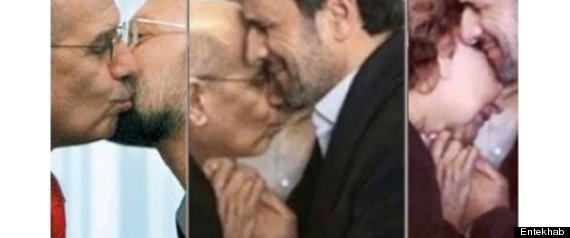
4. Tajikistan: The Wedding Singer
Who hasn’t gotten a little out of hand at the wedding of a close family member at one time or another? Tajikistan's President Emomali Rahmon might have been forgiven for being caught on tape at his son’s wedding singing and dancing enthusiastically (some claim drunkenly) to a popular song. Although the wedding took place in 2007, the video was uploaded to YouTube last month and has garnered more than 350,000 views to date.
In response, the government banned YouTube in the country- the third time in the past year. With elections coming up in November, it’s possible that this was a face-saving maneuver by the government. However, the attempted blockade seems to be drawing more, rather than less, attention to the impromptu nuptial escapades. It’s also likely that for some citizens of Tajikistan, lack of access to the Internet is far more upsetting than the president’s tone-deaf singing.
5. Mexico: Tongue Twister
It was just a small verbal slip-up. In January, Mexican President Peña Nieto was giving a speech and struggled over the pronunciation of a public agency called the Instituto Federal de Acceso a la Información y Protección de Datos or, in English, the Federal Institute of Access to Information and Data Protection. A YouTube video shows Peña Nieto stumbling over a few variations of the name in Spanish. The moment honestly looks pretty harmless at first glance but the verbal stumble took on a more sinister tone when the 41-second clip was blocked on YouTube due to a supposed copyright claim. Critics charged that the government was trying to censor the misstep and the over-reaction confirmed the fears of opposition members that Peña Nieto’s Institutional Revolutionary Party (PRI), back in office after a 12-year hiatus, was returning to its anti-democratic, heavy handed censoring ways.
6. Egypt: Mubarak Takes the Lead
When then-Egyptian President Hosni Mubarak met with U.S. President Obama and a group of Middle Eastern leaders in 2010, the Egyptian state-run newspaper Al Ahram ran a picture of Mubarak confidently leading everyone along the red carpet. But this was a very different image than what appeared elsewhere -- every other photograph of the day showed President Obama leading the pack with Mubarak trailing on the left.
It turns out that government-owned Al Ahram had doctored the original photo and moved Mubarak from the back of the pack to the front. Below you can see the original photo by the AP and the doctored version from Al Ahram’s website.
The chutzpah of the move is what’s most impressive here. The original version of the photograph ran in several other newspapers on the same day so it’s hard to imagine how anyone thought the fake photo would stand for very long. Al Ahram was eventually quoted by the Associated Press defending the photo as “’a brief, live and true expression’ of Mubarak's ‘unique role’ in ‘leading’ on the Palestinian issue.”
If the intent of the doctored photo was to show Mubarak’s international stature, it certainly backfired. Egyptians and the rest of the world were left with the image of an embattled president who was increasingly desperate to bolster his image as a leader.
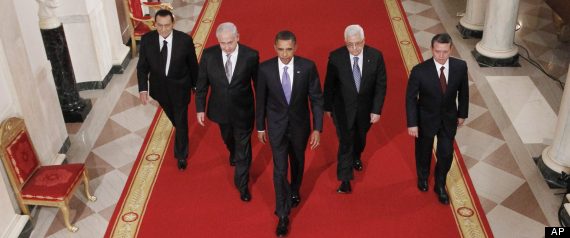 President Hosni Mubarak of Egypt, Prime Minister Benjamin Netanyahu of Israel, US President Barack Obama, President Mahmoud Abbas of the Palestinian Authority and King Abdullah II of Jordan walk to the East Room to make statements on the peace process on September 1, 2010 at the White House in Washington. (TIM SLOAN/AFP/Getty Images)
President Hosni Mubarak of Egypt, Prime Minister Benjamin Netanyahu of Israel, US President Barack Obama, President Mahmoud Abbas of the Palestinian Authority and King Abdullah II of Jordan walk to the East Room to make statements on the peace process on September 1, 2010 at the White House in Washington. (TIM SLOAN/AFP/Getty Images)
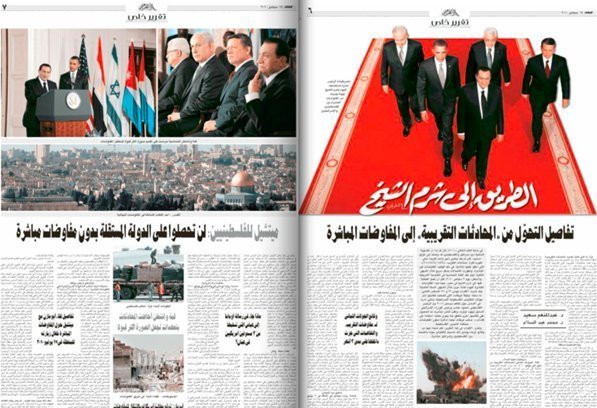
7. U.S.: Floodgate
When Vice President Al Gore was running for president in 1999, he was eager to spotlight environmental issues as part of his campaign platform. One way he sought to do this was with a photo op paddling in a canoe down the Connecticut River in New Hampshire during a campaign visit. However, Gore’s environmental message was soon overshadowed by the revelation that local authorities had granted Gore a special perk, releasing millions of gallons of water from a nearby dam to boost water levels and ensure Gore an aesthetically beautiful publicity photo.
The news quickly became a hot-button issue. The dam release was excoriated as hypocritical, costly and unnecessarily wasteful. Newspapers ran headlines condemning the “photo op from hell.” The Gore camp insisted that it had nothing to do with the release of water and were unaware that any special concessions had taken place. The Secret Service later admitted that it was responsible for the river dump as they feared for the vice president’s safety if water levels were too low. The company that operated the dam also said that it was routinely dumping millions of gallons of water into the river every day and that they had just moved up the timing of the latest release by a few hours to accommodate Gore.
However, these clarifications did little to silence Gore’s critics and "Floodgate" became an enduring touchstone for those wanting to debunk Gore’s environmental and ethical credibility.
 Vice-president Al Gore paddles a canoe down the Connecticut River in Windsor, Vt., as part of a campaign swing through New Hampshire, Thursday, July 22, 1999. (AP Photo/Toby Talbot)
Vice-president Al Gore paddles a canoe down the Connecticut River in Windsor, Vt., as part of a campaign swing through New Hampshire, Thursday, July 22, 1999. (AP Photo/Toby Talbot)
8. North Korea: Photoshop Fail: Cutoff At The Knees
The North Korean government has become infamous over the years for its tightly choreographed and painstakingly photoshopped versions of reality. (I refer you to the latest stories from North Korea announcing their discovery of an ancient unicorn lair and another adding several large warships to the photo of a military exercise.)
Back in 2008, there were many rumors that President Kim Jong-il was ailing and unable to govern after suffering a stroke. A series of pictures like the one below were dutifully released by the North Korean news agency showing the "Dear Leader" inspecting military operations and meeting with local troops.
But a closer look revealed some suspicious elements of the photograph like a knee level line that runs along the bottom of the photograph among the soldiers Kim is supposedly standing with, but stops just when it reaches his knees. Whether photoshopped or not, pictures which were meant to calm speculation about the president's health merely drew more attention to it. This photo and others raised intense speculation in the West about Kim’s long term prospects and ability to govern, though it is impossible to know whether these photos created similar concerns in the insular, Orwellian North Korean state.
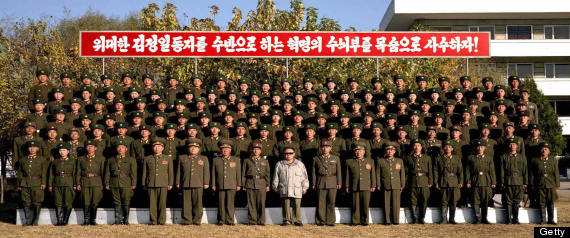 This undated picture released from Korean Central News Agency on November 5, 2008 shows North Korean leader Kim Jong-il (C) posing with soldiers as he inspects a drill ground of a sub-unit of Korean People's Army Unit 534 at an undisclosed location in North Korea. (KCNA/AFP/Getty Images)
This undated picture released from Korean Central News Agency on November 5, 2008 shows North Korean leader Kim Jong-il (C) posing with soldiers as he inspects a drill ground of a sub-unit of Korean People's Army Unit 534 at an undisclosed location in North Korea. (KCNA/AFP/Getty Images)
9. U.S.: Mission Accomplished
President George W. Bush’s “Mission Accomplished” speech in 2003 became an enduring image of the Iraq War- though not in the way it was originally intended.
To mark the end of major combat operations in Iraq, Bush arrived on the USS Abraham Lincoln in a fighter jet, wearing a flight suit, and flashing a thumbs-up in front of a banner reading “Mission Accomplished.” Since the Iraq War was still very much a mission in progress, the event prompted mockery and outrage. Bush supporters quickly pointed out that the president himself never used the phrase “Mission Accomplished,” and argued that the banner was supposed to refer to the tour of duty being over for the crew of the Lincoln, rather than for the entire Iraq War effort. The dramatic jet landing onto the deck of the carrier was also lambasted as an expensive and unnecessary stunt since the aircraft carrier was well within helicopter range. The White House contended that the arrival by jet was planned when the warship was farther off the coast and that officials had just stuck with that original plan.
Bush later admitted that the decision to put up a “Mission Accomplished” banner was a “mistake” that “sent the wrong message.”
Regardless of the truth behind the details of the day, the “Mission Accomplished” triumphalism remains a symbol for the Bush Administration’s profound miscalculation and lack of understanding of the complexities of the Iraq War.
 In this May 1, 2003 file photo, President George W. Bush speaks aboard the aircraft carrier USS Abraham Lincoln off the California coast. (AP Photo/J. Scott Applewhite, File)
In this May 1, 2003 file photo, President George W. Bush speaks aboard the aircraft carrier USS Abraham Lincoln off the California coast. (AP Photo/J. Scott Applewhite, File)
10. Italy: The “Bunga Bunga” Bungle
Corruption, bribery, perjury, colluding with the Mafia: Former Italian Prime Minister Silvio Berlusconi has been tried on all of these charges but never convicted, often because the statute of limitations had run out or because the offense had ceased to be a crime (thanks to legislation passed by his own government). Berlusconi also has been able to spin news coverage his way because he owns one of Italy’s biggest media empires, controlling the country’s three largest private TV channels, a daily newspaper and the largest publishing house.
But it looks like Berlusconi has run out of luck with his June 24 conviction on charges that he paid to have sex with an underage prostitute nicknamed "Ruby the Heart Stealer" at what have come to be known as Berlusconi’s “bunga bunga” sex parties. Berlusconi also was found guilty of abusing his office to spring her from jail on an unrelated offense.
Despite (or perhaps because of) his colorful history, Berlusconi’s popularity in Italy never seems to fully wane. Even with Berlusconi facing trial over abuse of power and sex with a minor, his coalition came extremely close to winning the general election earlier this year.
Berlusconi was sentenced to seven years in jail and a lifetime ban from public office. But he still has two rounds of appeals in which to argue his case. And even if the conviction stands, Italian courts usually don’t incarcerate people older than 70, meaning that the 76-year-old Berlusconi might be saved once again.
 Former Italian Prime Minister Silvio Berlusconi attends the confidence vote at the Senate on April 30, 2013 in Rome, Italy. (Photo by Franco Origlia/Getty Images)
Former Italian Prime Minister Silvio Berlusconi attends the confidence vote at the Senate on April 30, 2013 in Rome, Italy. (Photo by Franco Origlia/Getty Images)
Amanda Pike is the producer for The I Files, a project of The Center for Investigative Reporting. The I Files selects and showcases the best investigative videos from around the Web and across the world. Major contributors include CIR, The New York Times, BBC, ABC, Al-Jazeera, Vice TV and the Investigative News Network. You can follow Amanda on Twitter: @AmandaHPike. Learn more about The I Files: youtube.com/ifiles.